Seat Cordoba 2008 Owner's Manual
Manufacturer: SEAT, Model Year: 2008, Model line: Cordoba, Model: Seat Cordoba 2008Pages: 258, PDF Size: 7.87 MB
Page 231 of 258
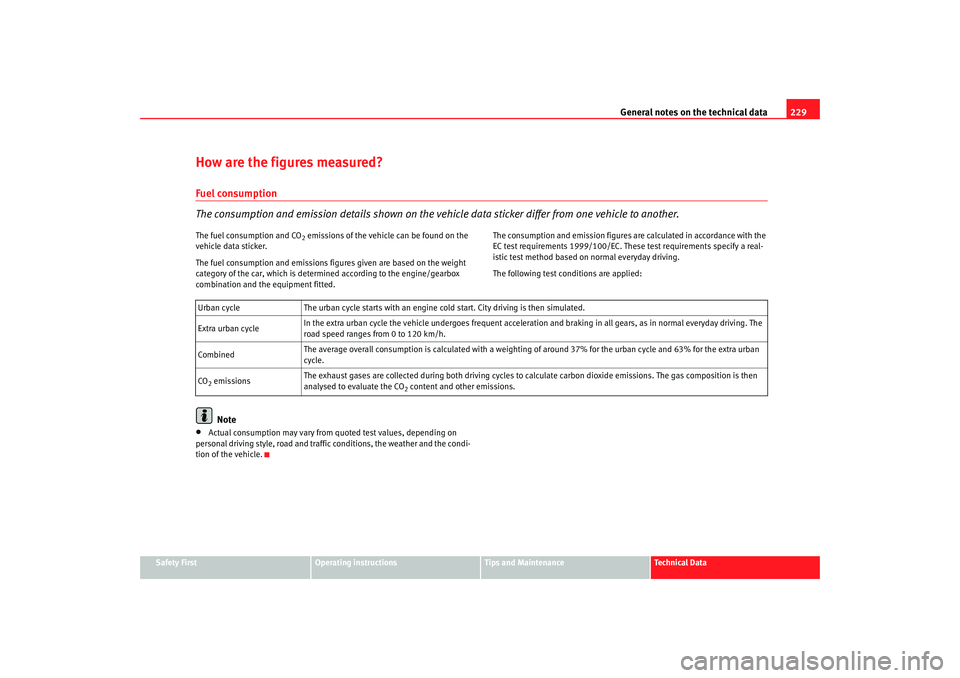
General notes on the technical data 229
Safety First
Operating instructions
Tips and Maintenance
Te c h n i c a l D a t a
How are the figures measured?Fuel consumption
The consumption and emission details shown on the vehi cle data sticker differ from one vehicle to another.The fuel consumption and CO
2 emissions of the vehicle can be found on the
vehicle data sticker.
The fuel consumption and emissions figures given are based on the weight
category of the car, which is determined according to the engine/gearbox
combination and the equipment fitted. The consumption and emission figures are calculated in accordance with the
EC test requirements 1999/100/EC. The
se test requirements specify a real-
istic test method based on normal everyday driving.
The following test conditions are applied:
Note
•
Actual consumption may vary from quoted test values, depending on
personal driving style, road and traffic conditions, the weather and the condi-
tion of the vehicle. Urban cycle
The urban cycle starts with an engine cold start. City driving is then simulated.
Extra urban cycle In the extra urban cycle the vehicle undergoes frequent acceleration
and braking in all gears, as in normal everyday driving. The
road speed ranges from 0 to 120 km/h.
Combined The average overall consumption is calculat
ed with a weighting of around 37% for the urban cycle and 63% for the extra urban
cycle.
CO2 emissions The exhaust gases are collected during both driving cycles to calculate carbon dioxide emissions. The gas composition is then
analysed to evaluate the CO
2 content and other emissions.
COR_ING_0707 Seite 229 Mittwoch, 1. August 2007 6:25 18
Page 232 of 258
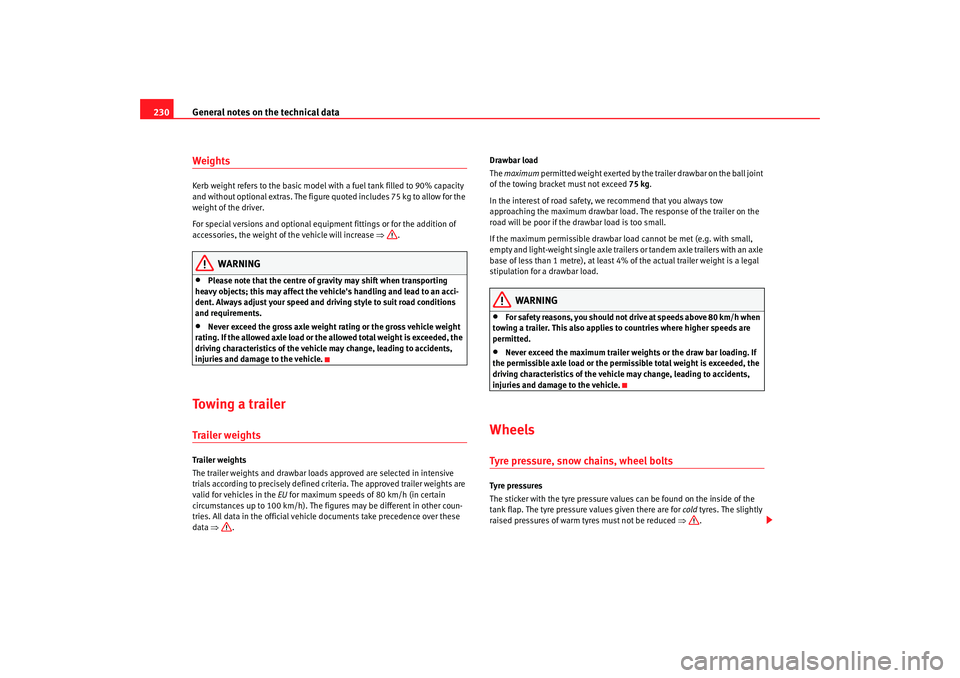
General notes on the technical data
230WeightsKerb weight refers to the basic model with a fuel tank filled to 90% capacity
and without optional extras. The figure quoted includes 75 kg to allow for the
weight of the driver.
For special versions and optional equipment fittings or for the addition of
accessories, the weight of the vehicle will increase ⇒.
WARNING
•
Please note that the centre of gravity may shift when transporting
heavy objects; this may affect the vehi cle's handling and lead to an acci-
dent. Always adjust your speed and dr iving style to suit road conditions
and requirements.
•
Never exceed the gross axle weight rating or the gross vehicle weight
rating. If the allowed axle load or the allowed total weight is exceeded, the
driving characteristics of the vehicle may change, leading to accidents,
injuries and damage to the vehicle.
To w i n g a t r a i l e rTrailer weightsTrailer weights
The trailer weights and drawbar loads approved are selected in intensive
trials according to precisely defined criteria. The approved trailer weights are
valid for vehicles in the EU for maximum speeds of 80 km/h (in certain
circumstances up to 100 km/h). The figu res may be different in other coun-
tries. All data in the official vehicl e documents take precedence over these
data ⇒ . Drawbar load
The
maximum permitted weight exerted by the trailer drawbar on the ball joint
of the towing bracket must not exceed 75 kg.
In the interest of road safety, we recommend that you always tow
approaching the maximum drawbar load. The response of the trailer on the
road will be poor if th e drawbar load is too small.
If the maximum permissible drawbar load cannot be met (e.g. with small,
empty and light-weight single axle trailers or tandem axle trailers with an axle
base of less than 1 metre), at least 4% of the actual trailer weight is a legal
stipulation for a drawbar load.
WARNING
•
For safety reasons, you should not drive at speeds above 80 km/h when
towing a trailer. This also applies to countries where higher speeds are
permitted.
•
Never exceed the maximum trailer weights or the draw bar loading. If
the permissible axle load or the perm issible total weight is exceeded, the
driving characteristics of the vehicle may change, leading to accidents,
injuries and damage to the vehicle.
WheelsTyre pressure, snow chains, wheel boltsTyre pressures
The sticker with the tyre pressure values can be found on the inside of the
tank flap. The tyre pressure values given there are for cold tyres. The slightly
raised pressures of warm tyres must not be reduced ⇒.
COR_ING_0707 Seite 230 Mittwoch, 1. August 2007 6:25 18
Page 233 of 258

General notes on the technical data 231
Safety First
Operating instructions
Tips and Maintenance
Te c h n i c a l D a t a
Snow chains
Snow chains are only permitted on the front wheels and only for tyres 155/80
R13; 165/70 R14 and 185/80 R14. Snow ch
ains must have fine-pitch links
which do not protrude more than 15 mm, including tension device.
Remaining tyres can be fitted with chains no thicker than 9 mm.
Wheel bolts
After the wheels have been changed, the tightening torque of the wheel bolts
should be checked as soon as possible with a torque wrench ⇒. The tight-
ening torque for steel and alloy wheels is 120 Nm.
WARNING
•
Check the tyre pressure at least once per month. Correct tyre pressure
is very important. If the tyre pressure is too high or too low, there is an
increased danger of accidents, particularly at high speeds.
•
If the torque of the wheel bolts is too low, they could loosen whilst the
vehicle is in motion. Risk of accident! If the tightening torque is too high,
the wheel bolts and threads could be damaged.Note
We recommend that you ask your Authorised Service Centre for information
about appropriate wheel, tyre and snow chain size.
COR_ING_0707 Seite 231 Mittwoch, 1. August 2007 6:25 18
Page 234 of 258

Technical Data
232Te c h n i c a l D a t aChecking fluid levelsFrom time to time, the levels of the different fluids in the
vehicle must be checked. Never fi ll with incorrect fluids, to do
so may cause serious damage to the engine.
Radiator expansion tank
Engine oil dipstick.
Engine oil filler cap
Brake fluid reservoir
Battery
Windscreen washer fluid container
The checking and replenishment of the service fluids are carried out on the
components mentioned above. These operations are described in the
⇒ page 175. Overview
Further explanations, instructions and restrictions on the technical data are
contained as of
⇒page 227.
Note
The layout of parts may vary according to engine.
Fig. 161 Diagram for the
location of the various
elements
A1A2A3A4A5A6
COR_ING_0707 Seite 232 Mittwoch, 1. August 2007 6:25 18
Page 235 of 258
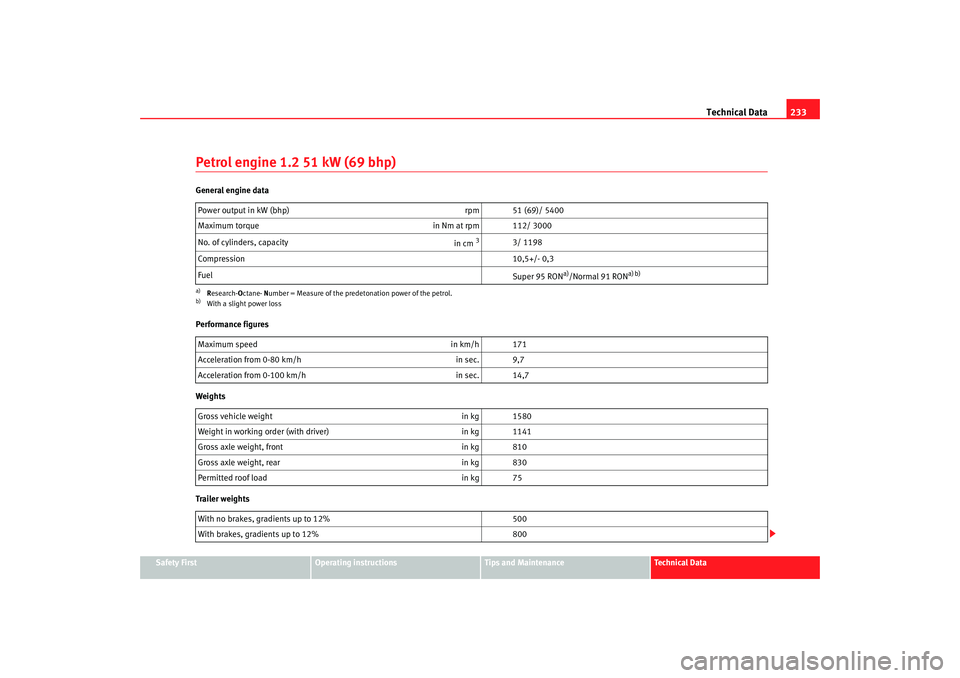
Technical Data233
Safety First
Operating instructions
Tips and Maintenance
Te c h n i c a l D a t a
Petrol engine 1.2 51 kW (69 bhp)General engine data
Performance figures
Weights
Trailer weightsPower output in kW (bhp)
rpm 51 (69)/ 5400
Maximum torque in Nm at rpm 112/ 3000
No. of cylinders, capacity in cm
3
3/ 1198
Compression 10,5+/- 0,3
Fuel Super 95 RON
a)/Normal 91 RON
a) b)
a)Research- Octane- Number = Measure of the predetonation power of the petrol.b)With a slight power lossMaximum speed in km/h 171
Acceleration from 0-80 km/h in sec. 9,7
Acceleration from 0-100 km/h in sec. 14,7
Gross vehicle weight in kg 1580
Weight in working order (with driver) in kg 1141
Gross axle weight, front in kg 810
Gross axle weight, rear in kg 830
Permitted roof load in kg 75
With no brakes, gradients up to 12% 500
With brakes, gradients up to 12% 800
COR_ING_0707 Seite 233 Mittwoch, 1. August 2007 6:25 18
Page 236 of 258
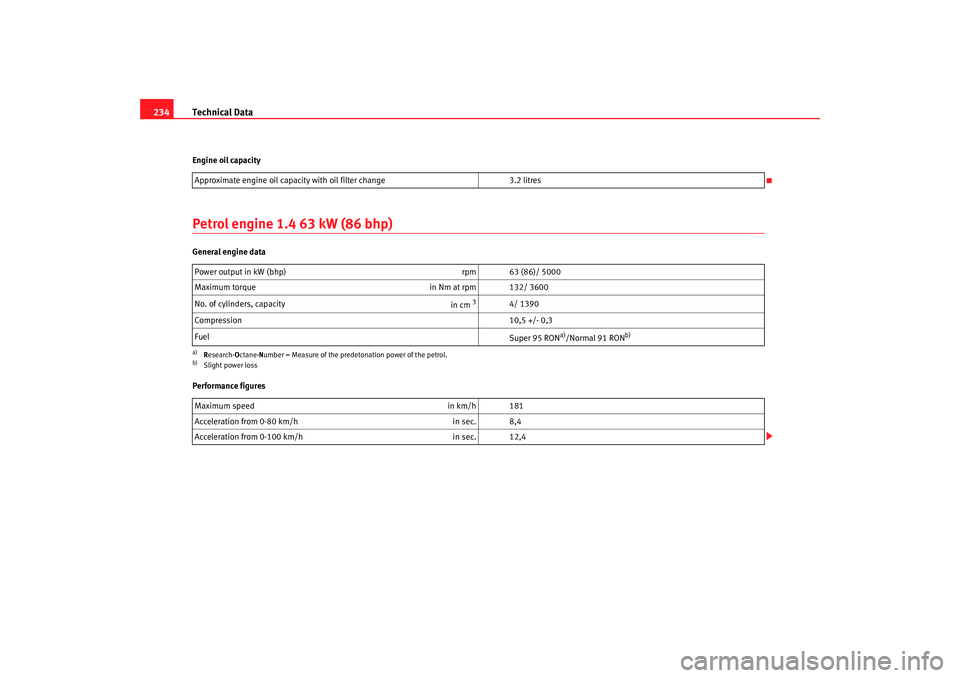
Technical Data
234Engine oil capacityPetrol engine 1.4 63 kW (86 bhp)General engine data
Performance figures Approximate engine oil capacity with oil filter change
3.2 litres
Power output in kW (bhp) rpm 63 (86)/ 5000
Maximum torque in Nm at rpm 132/ 3600
No. of cylinders, capacity in cm
3
4/ 1390
Compression 10,5 +/- 0,3
Fuel Super 95 RON
a)/Normal 91 RON
b)
a)Research- Octane- Number = Measure of the predetonation power of the petrol.b)Slight power lossMaximum speed in km/h 181
Acceleration from 0-80 km/h in sec. 8,4
Acceleration from 0-100 km/h in sec. 12,4
COR_ING_0707 Seite 234 Mittwoch, 1. August 2007 6:25 18
Page 237 of 258
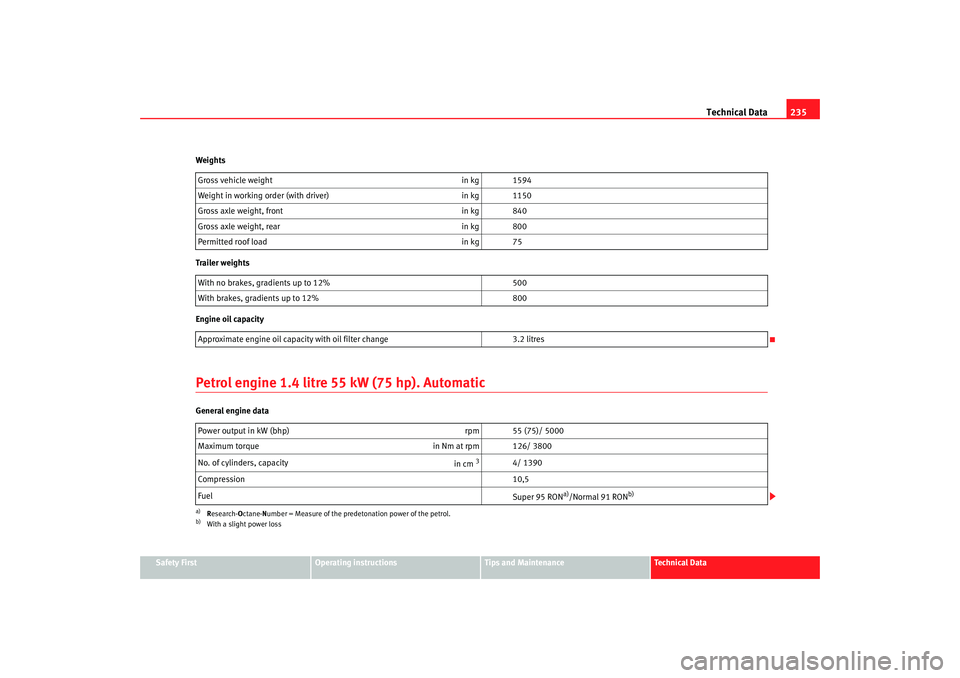
Technical Data235
Safety First
Operating instructions
Tips and Maintenance
Te c h n i c a l D a t a
Weights
Trailer weights
Engine oil capacity
Petrol engine 1.4 litre 55 kW (75 hp). AutomaticGeneral engine data
Gross vehicle weight
in kg 1594
Weight in working order (with driver) in kg 1150
Gross axle weight, front in kg 840
Gross axle weight, rear in kg 800
Permitted roof load in kg 75
With no brakes, gradients up to 12% 500
With brakes, gradients up to 12% 800
Approximate engine oil capacity with oil filter change 3.2 litres
Power output in kW (bhp) rpm 55 (75)/ 5000
Maximum torque in Nm at rpm 126/ 3800
No. of cylinders, capacity in cm
3
4/ 1390
Compression 10,5
Fuel Super 95 RON
a)/Normal 91 RON
b)
a)Research- Octane- Number = Measure of the predetonation power of the petrol.b)With a slight power loss
COR_ING_0707 Seite 235 Mittwoch, 1. August 2007 6:25 18
Page 238 of 258
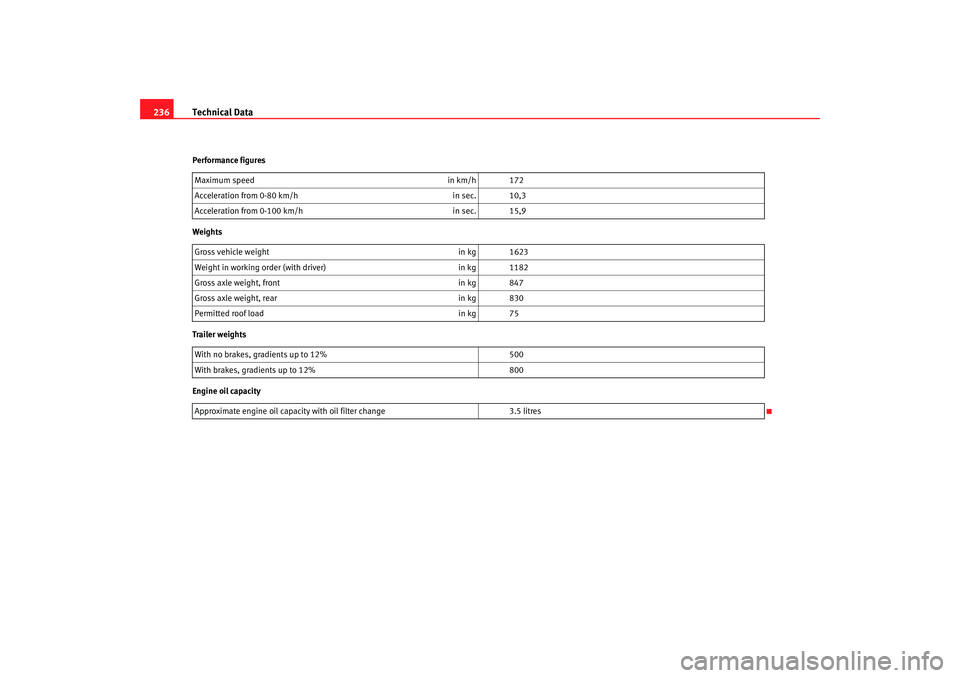
Technical Data
236Performance figures
Weights
Trailer weights
Engine oil capacity Maximum speed
in km/h 172
Acceleration from 0-80 km/h in sec. 10,3
Acceleration from 0-100 km/h in sec. 15,9
Gross vehicle weight in kg 1623
Weight in working order (with driver) in kg 1182
Gross axle weight, front in kg 847
Gross axle weight, rear in kg 830
Permitted roof load in kg 75
With no brakes, gradients up to 12% 500
With brakes, gradients up to 12% 800
Approximate engine oil capacity with oil filter change 3.5 litres
COR_ING_0707 Seite 236 Mittwoch, 1. August 2007 6:25 18
Page 239 of 258
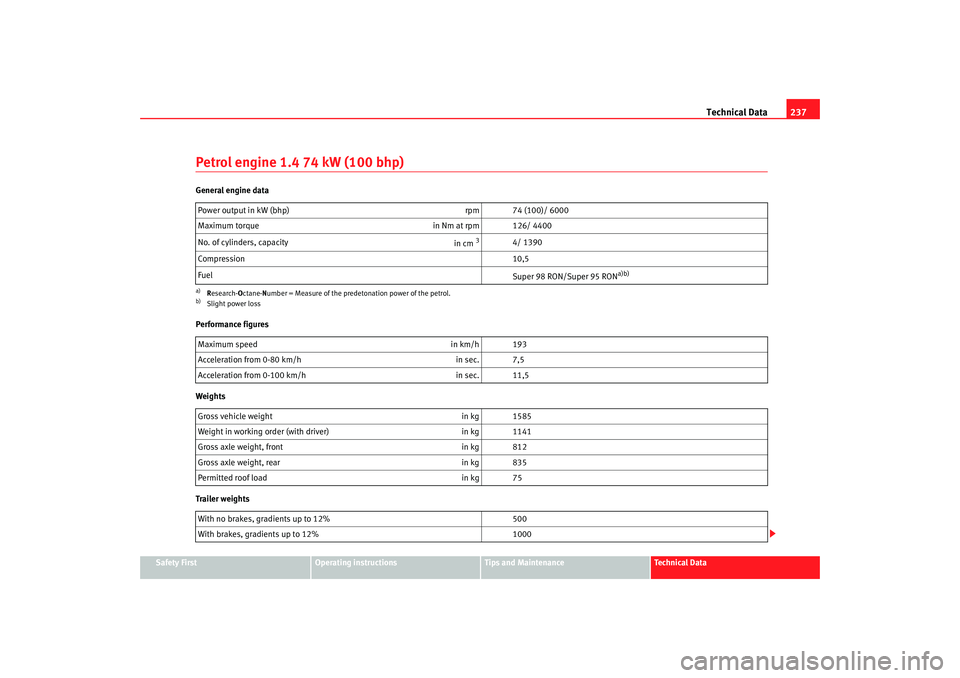
Technical Data237
Safety First
Operating instructions
Tips and Maintenance
Te c h n i c a l D a t a
Petrol engine 1.4 74 kW (100 bhp)General engine data
Performance figures
Weights
Trailer weightsPower output in kW (bhp)
rpm 74 (100)/ 6000
Maximum torque in Nm at rpm 126/ 4400
No. of cylinders, capacity in cm
3
4/ 1390
Compression 10,5
Fuel Super 98 RON/Super 95 RON
a)b)
a)Research- Octane- Number = Measure of the predetonation power of the petrol.b)Slight power lossMaximum speed in km/h 193
Acceleration from 0-80 km/h in sec. 7,5
Acceleration from 0-100 km/h in sec. 11,5
Gross vehicle weight in kg 1585
Weight in working order (with driver) in kg 1141
Gross axle weight, front in kg 812
Gross axle weight, rear in kg 835
Permitted roof load in kg 75
With no brakes, gradients up to 12% 500
With brakes, gradients up to 12% 1000
COR_ING_0707 Seite 237 Mittwoch, 1. August 2007 6:25 18
Page 240 of 258
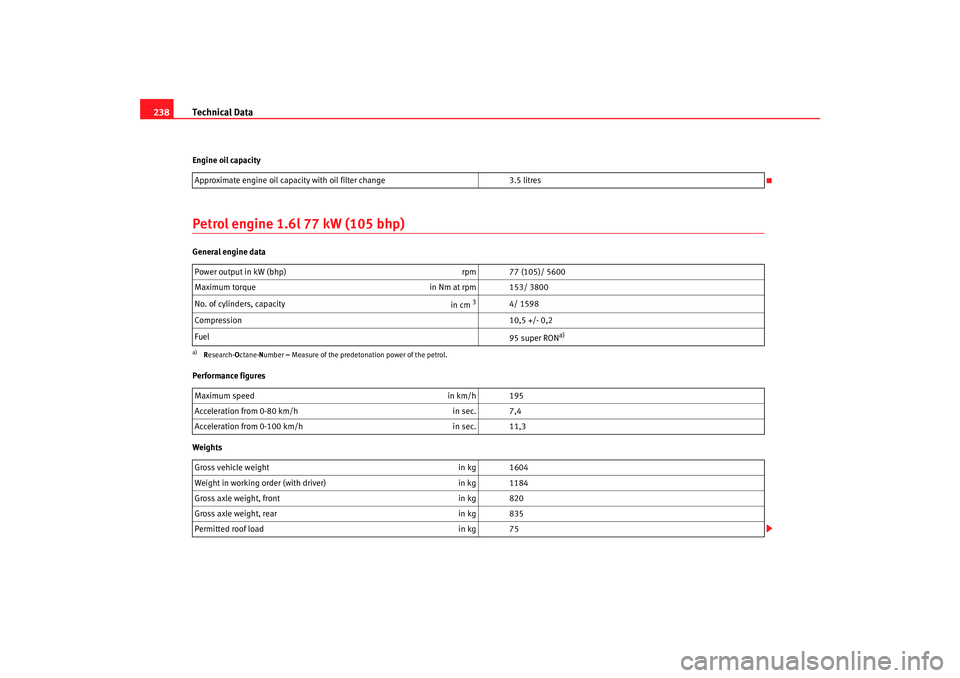
Technical Data
238Engine oil capacityPetrol engine 1.6l 77 kW (105 bhp)General engine data
Performance figures
Weights Approximate engine oil capacity with oil filter change
3.5 litres
Power output in kW (bhp) rpm 77 (105)/ 5600
Maximum torque in Nm at rpm 153/ 3800
No. of cylinders, capacity in cm
3
4/ 1598
Compression 10,5 +/- 0,2
Fuel 95 super RON
a)
a)Research- Octane- Number = Measure of the predetonation power of the petrol.Maximum speed in km/h 195
Acceleration from 0-80 km/h in sec. 7,4
Acceleration from 0-100 km/h in sec. 11,3
Gross vehicle weight in kg 1604
Weight in working order (with driver) in kg 1184
Gross axle weight, front in kg 820
Gross axle weight, rear in kg 835
Permitted roof load in kg 75
COR_ING_0707 Seite 238 Mittwoch, 1. August 2007 6:25 18